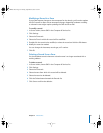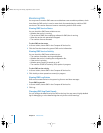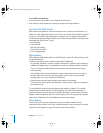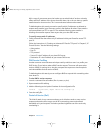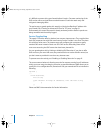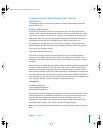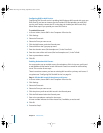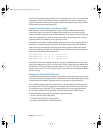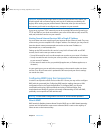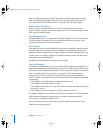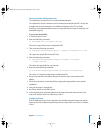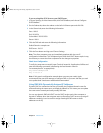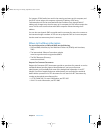
Chapter 2 DNS Service 35
Step 2: Create records and priorities for the auxiliary mail servers
These instruction assume you have edited the original MX record. If not, please do so
before proceeding.
These instructions also assume you have already set up and configured one or more
auxiliary mail servers.
To enable backup or redundant mail servers:
1 In Server Admin, select DNS in the Computers & Services pane.
2 Click Settings.
3 Select the Zones tab.
4 Select the Zone you want to use.
5 Click the Add button under the Records pane.
6 Choose MX from the Type pop-up menu.
7 Enter the domain name (like ‘example.com.’) in the From field.
8 Enter the name of the mail server (like ‘backup.example.com.’) in the To field.
9 Enter a precedence number for that server which is higher than that of the primary
server.
A higher the number indicates it will be chosen if the primary server is unavailable.
10 Click OK.
Setting Up Namespace Behind a NAT Router
If you’re behind a Network Address Translation (NAT) router, you have a special set of IP
addresses that are only usable within the NAT environment. If you were to assign a
domain name to these addresses outside of the NAT router, none of your domain
names would resolve to the correct computer. See Chapter 4, “NAT Service,” on page 67
for more information about NAT.
You can, however, run a DNS service behind the router, assigning host names to the
NAT IP addresses. This way, if you’re behind the NAT router, you can enter domain
names rather than IP addresses to access servers, services, and workstations. Your DNS
server should also have a Forwarding zone to send DNS requests outside of the NAT
router to allow resolution of names outside the routed area. Your clients’ networking
settings should specify the DNS server behind the NAT router. The process of setting up
one of these networks is the same as setting up a private network. See “Setting Up a
Private TCP/IP Network” on page 36 for more information.
If you choose to do this, names entered by users outside the NAT router won’t resolve
to the addresses behind it. You should set the DNS records outside the NAT-routed area
to point to the NAT router, and use NAT port forwarding to access computers behind
the NAT router. For more information on port forwarding, see Chapter 4, “NAT Service,”
on page 67.
LL2351.Book Page 35 Monday, September 8, 2003 2:47 PM



